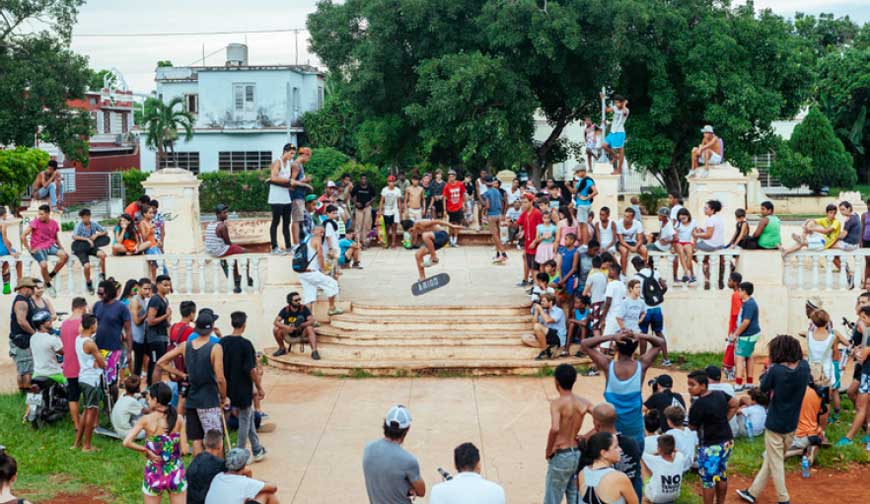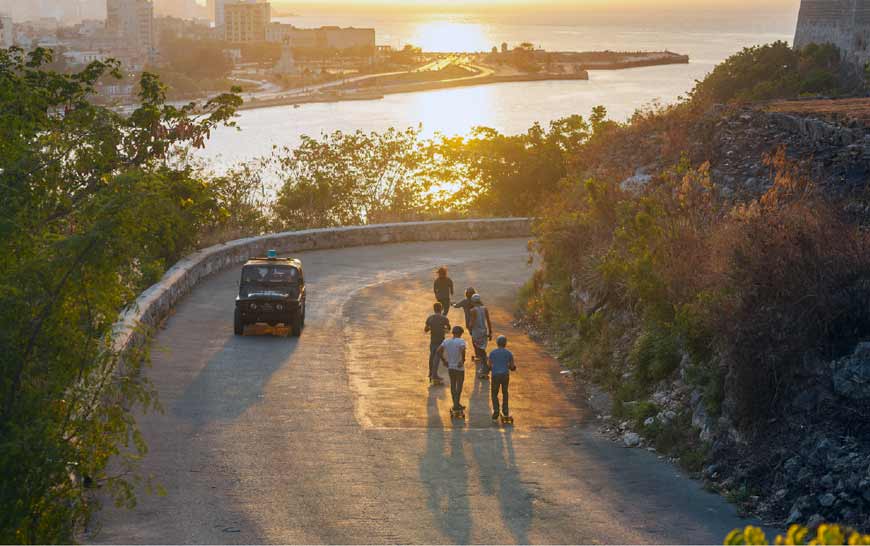
I’m not a skateboarder, but I somehow have become immersed into its culture of people, and especially taken in by the skateboarding scene in Cuba. The skaters’ attitudes and lifestyle inspire me. It sounds ludicrous when I tell people about my experience, but I am convinced it’s the simple life of the skateboarders that is revolutionizing an island filled with so many barriers and vulnerabilities. I truly believe that it’s these kids and the global supporters within the skateboard community over the past few years that have contributed to the sudden interest in the country and opening minds and borders. As someone said to me, the one thing the government can’t take away from you is the freedom of mobility.
The History of Skateboarding in Cuba
There’s a movement going on in Cuba, and it’s not being dictated by new relations with the United States or led by young guerrilla rebels, but by a wooden board with four wheels and the lifestyle of its occupants.
There’s an energy in the streets that you feel is about to burst. It screams to you all around. Attitudes have changed with a newer generation. Tito, an ambitious 25-year-old skateboarder in Havana, no longer believes in the walls that have surrounded the island. He tells me, if you have the dream, we will make it happen. The skateboard culture, with the help of global support organizations, has evolved into a culture of mentors and leaders on the island. They encompass the bubbling energy that fills the incandescent Cuban air.
One person who has a played a critical role in abetting the movement and creating these big dreams is Rene Lecour, who owns a skateboarding shop and manages a skatepark in Miami. Almost six years ago Rene’s then 15-year-old son Kaya Rain showed him a documentary on the impoverished Cuban skateboarding scene. Rene and his family reached out to their local community for donations. Soon they had arranged a trip to Cuba’s capital city of Havana, with bags full of used boards and gear.
Before entering Cuba, Rene was unsure how to reach the skateboarding community there. But he need not have worried; they found him. While unpacking his suitcase an hour after his arrival, Rene heard an assemblage of skateboards approaching the hotel. Upon hearing the boards, Kaya urged him to come downstairs.
Standing before them, in front of the blue fountains that sit along the Malecon, was a man Rene had learned of while researching Cuban skating: Che Alejandro Paydo Napoles, one of the early adopters of skateboarding in the country. And standing behind Che was every skater in Havana.
Rene looked him up and down in disbelief.
“Che?” he asked.
“Amigo!” Che responded with a handshake, and from there Amigo Skate was born. As people say, things like this only happen in Cuba. Che says his first recollection of seeing a skateboard in Cuba was in 1981, when revolutionaries traveling back and forth to Russia, Czechoslovakia and Bulgaria would bring back skateboards as gifts for their kids. Little did they know they were seeding a brand new lifestyle, and eventually a new revolution.
Che says he started skating when he was about 9 or 10, after seeing groups of guys skating in Acapulco Park. One of the people Che skated with, also about his same age, was Canek Sanchez Guevara, the eldest grandson of the iconic revolutionary leader Che Guevara. Though Canek revered his grandfather, he later strongly opposed the regime, disappointed by what the elder Guevara’s revolution had turned into.
The scene eventually grew inside the park at 23rd and G Streets. There a group of about 30 long-haired kids, inspired by movies like Kids and Thrashin’, would spend their days listening to rock ’n’ roll, riding downhill, trying new tricks and hanging out. They’d meet up at the park every morning and then again in the evening.
“Doesn’t matter if you skate good or bad in the ’80s,” says Che, now 42 years old. “It was just about having fun with your friends.” Before donations, Cuban skaters had to make their own boards out of pieces of plywood and steel wheels taken from1940s roller skates. Eventually Che built a machine that helped shape their homemade boards. Today they completely depend on donations. In Cuba, a skater lasts as long as his or her board. Once you break the board, you have to wait for the next shipment to come in.
After years of skating only streets and hills, Cuban skaters got to ride their first skate ramp in 2005, with the entrance of Red Bull. Soon after, they began building and carrying around rickety ramps that they could set up as mobile skateparks. They would inhabit an area for as long as they could, but eventually they would always get kicked out. Today, though, a DIY park exists in an old drainage ditch outside of Havana’s Sports City, with concrete ramps that were just completed this past summer.
But the streets of the city are Cuban skaters’ real park. In a place where the landscape is of a time that has stood still, the island of Cuba sets the most beautiful scene for a skating playground. Riders grab the back bumpers of old 1960s cars and the sides of Tuk Tuks (auto rickshaws) in between traffic, or jump and perform tricks along the structures of the Malecon. This will always be a constant even throughout the evolution of skating on the island.
An Evolution
Once looked at as punks, misfits and rebels, today skaters are seen as the new Cuban thought leaders. But it was rebellion that got them here, and it’s still rebellion that continues to create change. On June 21, 2015 Amigo Skate pioneered Go Skateboarding Day on the island. Like a scene out of Braveheart, 100 skateboarders brought liberation to Cuba for the first time in almost 60 years. They made an 11-mile loop around the city, riding together while waving high both a Cuban flag and an American flag. Cubans rushed out of their homes to watch, cheering them on, following them down the streets, taking photos and shedding tears of joy and freedom. For the first 15 minutes the skaters rode as fast as they could, awaiting their inevitable arrest for illegally flying the flags. But the arrest never came; the police just looked the other way and quietly celebrated. As the skaters finally slowed down, one of the youngest riders in the group, around 10 years old, began yelling out, “It’s happening! It’s happening!”
The day also ended like a scene out of a movie, and yet as perfectly simple as life in Cuba, with riders sharing beers on the edge of the Malecon. But in the air was change. The afternoon had given empowerment to the impossible. And it was skateboarders who had raised the American flag for the first time again in Cuba, two months before the flag was lifted in front of the new U.S. Embassy. Rene Lecour said it was the best day of his entire life.
He may soon have a few more of those. As a gift back to the people, Amigo Skate is producing the first-of-its-kind action sports, music, and arts festival in Havana, bringing in artists from both the U.S. and Canada. They are also in negotiation with the government, collaborating on the plans for a new skatepark that will overlook the Malecon. In five years Amigo Skate has spread globally, allowing them to make mission trips every couple of months.
A part of the lifestyle is street art, on which Amigo Skate has also had a major influence and found ways to bring in supplies. Abstrk, a Miami-based graffiti artist, has adopted the Amigo name for his project, Amigo Paint. He goes into parks and elementary schools, working on collaborations with the kids, reaching communities the government has yet to reach.
Back in May, Tito and a bunch of other local Havana skateboarders were asked to help a Parisian artist named Steeve Bauras build an exhibition called 3K Project for the Havana Biennial Art Exhibition. They built an indoor skate ramp, which they then painted black, along with the ramps, the walls and the speakers. Then shadows of all colors each took turns riding up and down the ramps.
When I chatted with Bauras about 3K and the reason for the black setting, the darkness in his words and the racial and controversial film clip he chose to use in the background, he said it represents a movement. The black and white is a canvas. He says people might see it as only black and white, but he sees color. And I asked, why skateboarders? He said because it’s a culture that has brought so many different types of people together – a culture that has broken the segregated barriers. It’s a movement.
An icon of revolution is stamped all over Cuba. The face of “Heroic Guerrilla Fighter” of Che Guevara still appears on virtually every block. You are constantly reminded of a historical movement that brought so much upheaval to a country in the 1960s.
But more than 60 years later, another symbol has dominated the island. This  symbol is tattooed to the bodies of the youth, tagged on walls and spray-painted on almost every skateboard that glides down the street. The symbol consists of two skateboards forming the shape of a heart holding hands, beneath which it reads “Amigo Skate.” This symbol represents a very different kind of movement and lifestyle. It represents freedom, friendship, and, for me, a blank canvas for the future, just like Bauras was talking about.
symbol is tattooed to the bodies of the youth, tagged on walls and spray-painted on almost every skateboard that glides down the street. The symbol consists of two skateboards forming the shape of a heart holding hands, beneath which it reads “Amigo Skate.” This symbol represents a very different kind of movement and lifestyle. It represents freedom, friendship, and, for me, a blank canvas for the future, just like Bauras was talking about.
My first night in Cuba, an overwhelming sensation of tranquility came over me. I found myself walking down a street in Vedado at 3:00 in the morning heading toward the Malecon. I stood next to a skater named Rodney, where music was playing from his boombox. Innocence filled the air, the sky perfectly lit by the stars. Skateboarders rolled by, trying out new tricks, while some of us walked in silence in our own thoughts, and others quietly conversed. Although the group was scattered along the street, our bodies moved together slowly as one peaceful force. The next day I called Rene and said, “I get it.”
Amigo Skate extends a huge thanks to the following companies for their generous support: Madrid, Fender, Havana Air, Cadillac Wheels, Arbor, Caliber Trucks, Generator Skateboards, Huff, S-One Helmets, The Hundreds, Homage Skateshop, Shut Skateboards and Churchills Pub
For more information on the Amigo Skate mission, visit www.amigoskate.com.
Thankyou to Concrete Wave Magazine
Issue: Fall Sept 2015
